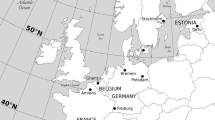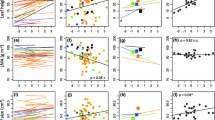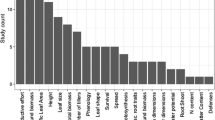Abstract
Empirical studies that link plants intraspecific variation to environmental conditions are almost lacking, despite their relevance in understanding mechanisms of plant adaptation, in predicting the outcome of environmental change and in conservation. Here, we investigate intraspecific trait variation of four grassland species along with abiotic environmental variation at high spatial resolution (n = 30 samples per species trait and environmental factor per site) in two contrasting grassland habitats in Central Apennines (Italy). We test for phenotypic adaptation between habitats, intraspecific trait-environment relationships within habitats, and the extent of trait and environmental variation. We considered whole plant, clonal, leaf, and seed traits. Differences between habitats were tested using ANOVA and ANCOVA. Trait-environment relationships were assessed using multiple regression models and hierarchical variance partitioning. The extent of variation was calculated using the coefficient of variation. Significant intraspecific differences in trait attributes between the contrasting habitats indicate phenotypic adaptation to in situ environmental conditions. Within habitats, light, soil temperature, and the availability of nitrate, ammonium, magnesium and potassium were the most important factors driving intraspecific trait-environment relationships. Leaf traits and height growth show lower variability than environment being probably more regulated by plants than clonal traits which show much higher variability. We show the adaptive significance of key plant traits leading to intraspecific adaptation of strategies providing insights for conservation of extant grassland communities. We argue that protecting habitats with considerable medium- and small-scale environmental heterogeneity is important to maintain large intraspecific variability within local populations that finally can buffer against uncertainty of future climate and land use scenarios.

Similar content being viewed by others

Abbreviations
- SLA:
-
Specific leaf area
- LDMC:
-
Leaf dry matter content
References
Ackerly DD, Cornwell WK (2007) A trait-based approach to community assembly: partitioning of species trait values into within- and among-community components. Ecol Lett 10:135–145
Albert CH, Thuiller W, Yoccoz NG, Douzet R, Aubert S, Lavorel S (2010) A multi-trait approach reveals the structure and the relative importance of intra vs. interspecific variability in plant traits. Funct Ecol 24:1192–1201
Al Haj Khaled R, Duru M, Theau JP, Plantureux S, Cruz P (2005) Variation in leaf traits through seasons and N-availability levels and its consequences for ranking grassland species. J Veg Sci 16:391–398
Badyaev AV (2009) Evolutionary significance of phenotypic accommodation in novel environments: an empirical test of the Baldwin effect. Phil Trans R Soc B 364:1125–1141
Barriopedro D, Fischer EM, Luterbacher J, Trigo RM, Garcia-Herrera R (2011) The hot summer of 2010: redrawing the temperature record map of Europe. Science 332:220–224
Barker G, Grant A, Beavitt P, Christie N, Giorgi J, Hoare P, Leggio T, Migliavacca M (1991) Ancient and Modern Pastoralism in Central Italy: an Interdisciplinary Study in the Cicolano Mountains. Papers of the British School at Rome 59:15–88
Baskin CC, Baskin JM (1998) Seeds: Ecology, biogeography, and evolution of dormancy and germination. Academic Press, San Diego
Beier P, Brost B (2010) Use of land facets to plan for climate change: conserving the arenas, not the actors. Conserv Biol 24:701–710
Bolnick DI, Svanbäck R, Fordyce JA, Yang LH, Davis JM, Hulsey CD, Forister ML (2003) The ecology of individuals: incidence and implications of individual specialization. Am Nat 161:1–28
Bossdorf O, Richards CL, Pigliucci M (2008) Epigenetics for ecologists. Ecol Lett 11:106–115
Branch NP (2012) Early-Middle Holocene vegetation history, climate change and human activities at Lago Riane (Ligurian Apennines, NW Italy). Veg Hist Archeobot. Published online 21 November 2012
Buckley RC (1982) Seed size and seedling establishment in tropical arid dunecrest plants. Biotropica 14:314–315
Burdon JJ (1987) Phenotypic and genetic patterns of resistance to the pathogen Phakopsora pachyrhizi in populations of Glycine canescens. Oecologia 73:257–267
Carter EB, Theodorou MK, Morris P (1997) Responses of Lotus corniculatus to environmental change. New Phytol 36:245–253
Cornelissen JHC, Lavorel S, Garnier E, Díaz S, Buchmann N, Gurvich DE, Reich PB, ter Steege H, Morgan HD, van der Heijden MGA, Pausas JG, Poorter H (2003) A handbook of protocols for standardised and easy measurement of plant functional traits worldwide; in. Aust J Bot 51:335–380
Garnier E, Laurent G, Bellmann A, Debain S, Berthelier P, Ducout B, Roumet C, Navas ML (2001) Consistency of species ranking based on functional leaf traits. New Phytol 152:69–83
Garnier E, Cortez J, Billes G, Navas ML, Roumet C, Debussche M, Laurent G, Blanchard A, Aubry D, Bellmann A, Neill C, Toussaint JP (2004) Plant functional markers capture ecosystem properties during secondary succession. Ecology 85:2630–2637
Grassein F, Till-Bottraud I, Lavorel S (2010) Plant resource-use strategies: the importance of phenotypic plasticity in response to a productivity gradient for two subalpine species. Ann Bot 106:637–645
Grime JP (1994) The role of plasticity in exploiting environmental heterogeneity. In: Caldwell MM, Pearcy R (eds) Exploitation of Environmental Heterogeneity in Plants. Academic press, San Diego, pp 1–18
Grime JP (2002) Plant strategies, vegetation processes, and ecosystem properties, 2nd edn. Wiley, Chichester
Gross N, Suding KN, Lavorel S (2007) Leaf dry matter content and lateral spread predict response to land use change for six subalpine grassland species. J Veg Sci 18:289–300
Groves CR, Game ET, Anderson MG, Cross M, Enquist C, Ferdaña Z, Girvetz E, Gondor A, Hall KR, Higgins J, Marshall R, Popper K, Schill S, Shafer SL (2012) Incorporating climate change into systematic conservation planning. Biodivers Conserv 21:1651–1671
Grömping U (2006) Relative importance for linear regression in R: the package relaimpo. J Stat Softw 17:1–27
Halassy M, Campetella G, Canullo R, Mucina L (2005) Patterns of functional clonal traits and clonal growth modes in contrasting grasslands in the central Apennines, Italy. J Veg Sci 16:29–36
Hodgson JG, Mackey JML (1986) The ecological specialisation of dicotyledonous families within a local flora: some factors constraining optimization of seed size and their evolutionary significance. New Phytol 12:497–515
Hoffmann G (1991) Die Untersuchung von Böden – Methodenbuch 1. VDLUFA-Verlag, Darmstadt
Hulshof CM, Swenson NG (2010) Variation in leaf functional trait values within and across individuals and species: an example from a Costa Rican dry forest. Funct Ecol 24:217–223
IPCC (2012) Managing the risks of extreme events and disasters to advance climate change adaptation. A special report of working Groups I and II of the intergovernmental panel on climate change. In: Field CB, Barros V, Stocker TF et al (eds) Cambridge University Press, Cambridge, UK, and New York, NY, USA, 582 pp
ISTA (International Society of Testing Analysis) (1999) International rules for seed testing. Seed Sci Technol 27(supplement):201–244
Kleyer M, Bekker RM, Knevel IC, Bakker JP, Thompson K, Sonnenschein M, Poschlod P, van Groenendael JM, Klimes L, Klimesová J, Klotz S, Rusch GM, Hermy M, Adriaens D, Boedeltje G, Bossuyt B, Endels P, Götzenberger L, Hodgson JG, Jackel A-K, Dannemann A, Kühn I, Kunzmann D, Ozinga WA, Römermann C, Stadler M, Schlegelmilch J, Steendam HJ, Tackenberg O, Wilmann B, Cornelissen JHC, Eriksson O, Garnier E, Fitter A, Peco B (2008) The LEDA Traitbase: a database of plant life-history traits of North West European Flora. J Ecol 96:1266–1274
Klimešová J, Klimeš L (2006) CLO-PLA3: a database of clonal growth architecture of Central-European plants. http://clopla.butbn.cas.cz
Knevel IC, Bekker RM, Kunzmann D, Stadler M, Thompson K (2005) The LEDA Traitbase collecting and measuring standards of life-history traits of the NW European flora. Published by the University of Groningen, Groningen
Kwiatkowski W, Venanzoni R (1994) Carta dei suoli della riserva naturale di Torricchio. La Riserva Naturale di Torricchio 9:15–21
Leishman MR, Westoby M (1994) The role of seed size in seedling establishment in dry soil conditions – experimental evidence from semi-arid species. J Ecol 82:249–258
Lemke I, Kolb A, Diekmann M (2012) Region and site conditions affect phenotypic trait variation in five forest herbs. Acta Oecol 39:18–24
Linhart YB (1988) Intra-population differentiation in annual plants. III. The contrasting effects of intra- and inter-specific competition. Evolution 42:1047–1064
Linhart YB, Grant MC (1996) Evolutionary significance of local genetic differentiation in plants. Annu Rev Ecol Syst 27:237–277
Mawdsley JR, O’Malley R, Ojima DS (2009) A Review of climate-change adaptation strategies for wildlife management and biodiversity conservation. Conserv Biol 2:1080–1089
Maillette C (1992) Seasonal model of modular growth in plants. J Ecol 80:123–130
Mazer SJ (1989) Ecological, taxonomic and life history correlates of seed mass among Indiana Dune angiosperms. Ecol Monogr 59:153–175
McCarthy MC, Enquist BJ (2007) Consistency between an allometric approach and optimal partitioning theory in global patterns of plant biomass allocation. Funct Ecol 21:713–720
Miner BG, Sultan SE, Morgan SG, Padilla DK, Relyea RA (2005) Ecological consequences of phenotypic plasticity. Trends Ecol Evol 20(12):685–692
Moles AT, Westoby M (2006) Seed size and plant strategy across the whole life cycle. Oikos 113:91–105
Murray K, Conner MM (2009) Methods to quantify variable importance: implications for the analysis of noisy ecological data. Ecology 90:348–355
Nicotra AB, Atkin OK, Bonser SP, Davidson AM, Finnegan EJ, Mathesius U, Poot P, Purugganan MD, Richards CL, Valladares F, van Kleunen M (2010) Plant phenotypic plasticity in a changing climate. Trends Plant Sci 15:684–992
Oborny B, Bartha S (1995) Clonality in plant communities – An overview. Abstracta Botanica 19:115–127
Pakeman RJ, Garnier E, Lavorel S, Ansquer P, Castro H, Cruz P, Dolezal J, Eriksson O, Freitas H, Golodet C, Kigel J, Kleyer M, Leps J, Meier T, Papadimitriou M, Papanastasi VP, Quested H, Quetier F, Rusch G, Sternberg M, Theau JP, Thebault A, Vile D (2008) Impact of abundance weighting on the response of seed traits to climate and land use. J Ecol 96:355–366
Peat HJ, Fitter AH (1994) Comparative analyses of ecological characteristics of British angiosperms. Biol Rev 69:95–115
Pierce S, Luzzaro A, Caccianiga M, Ceriani RM, Cerabolini B (2007) Disturbance is the principal α-scale filter determining niche differentiation, coexistence and biodiversity in an alpine community. J Ecol 95:698–706
Pignatti S (1982) Flora d’Italia. Edagricole, Bologna
Poorter H, Pepin S, Rijkers T, De Jong Y, Evans JR, Körner C (2006) Construction costs, chemical composition, and payback time of high and low irradiance leaves. J Exp Bot 57:355–371
Poorter H, Niinemets Ü, Poorter L, Wright IJ, Villar R (2009) Causes and consequences of variation in leaf mass per area (LMA): a meta-analysis. New Phytol 182:565–588
R Development Core Team (2010) R: A language and environment for statistical computing. R version 2.13.1. Foundation for Statistical Computing. Vienna, Austria, http://www.R-project.org
Reich PB, Wright IJ, Cavender-Bares J, Craine JM, Oleksyn J, Westoby M, Walters MB (2003) The evolution of plant functional variation: traits, spectra and strategies. Int J Plant Sci 164:S143–S164
Ryser P, Urbas P (2000) Ecological significance of leaf life span among Central European grass species. Oikos 91:41–50
Schellenberg J, Pontes S (2012) Plant functional traits and nutrient gradients on grassland. Grass Forage Sci 67:305–319
Silvertown J (2004) Plant coexistence and the niche. Trends Ecol Evol 19:605–611
Simms EL (1990) Examining selection on the multivariate phenotype: plant resistance to herbivores. Evolution 44:1177–1188
Stanton ML (1984) Seed variation in wild radish: effect of seed size on components of seedlings and adult fitness. Ecology 65:1105–1112
Stöcklin J (1992) Umwelt, Morphologie und Wachstumsmuster klonaler Pflanzen - eine Übersicht. Bot Helv 102:3–21
Sultan SE (1987) Evolutionary implications of phenotypic plasticity in plants. In: Hecht MK, Wallace B, Prance GT (eds) Evolutionary Biology, Vol 21. Springer, New York, pp 127–178
Tissue DT, Nobel PS (1988) Parent-ramet connections in Agave desert: influences of carbohydrates on growth. Oecologia 75:266–271
Turkington R (1989) The growth, distribution, and neighbour relationships of Trifolium repens in a permanent pasture. V. The coevolution of competitors. J Ecol 77:717–733
Turkington R, Aarssen LW (1984) In: Dirzo R, Sarukhan J (eds) Local scale differentiation as a result of competitive interactions. Sunderland, MA, Perspectives in Plant Population Ecology. Sinauer, pp 107–127
Venanzoni R, Kwiatkowski W (1995) Analisi integrata del paesaggio in un settore dell’Appennino Centrale (Riserva naturale Montagna di Torricchio). Colloq Phytosociol 24:187–201
Violle C, Enquist BJ, McGill BJ, Jiang L, Albert CH, Hulshof C, Jung V, Messier J (2012) The return of the variance: intraspecific variability in community ecology. Trends Ecol Evol 27(4):244–252
Walck JL, Hidayati SN, Dixon KW, Thompson K, Poschlod P (2011) Climate change and plant regeneration from seed. Glob Change Biol 17:2145–2161
Webb CT, Hoeting JA, Ames GM, Pyne MI, Poff NL (2010) A structured and dynamic framework to advance traits-based theory and prediction in ecology. Ecol Lett 13:267–283
Wellstein C (2012) Seed–litter–position drives seedling establishment in grassland species under recurrent drought. Plant Biol 14:1006–1010
Wellstein C, Kuss P (2011) Diversity and frequency of clonal traits along natural and land-use gradients in grasslands of the Swiss Alps. Folia Geobot 46:255–270
Wellstein C, Schröder B, Reineking B, Zimmermann NE (2011) Understanding species and community response to environmental change – A functional trait perspective. Agr Ecosyst Environ 145:1–4
West-Eberhard MJ (2005) Phenotypic accommodation: adaptive innovation due to developmental plasticity. J Exp Zool B 304:610–618
Westoby M (1998) A leaf-height-seed (LHS) plant ecology strategy scheme. Plant Soil 199:213–227
Westoby M, Falster DS, Moles AT, Vesk PA, Wright IJ (2002) Plant ecological strategies: some leading dimensions of variation between species. Annu Rev Ecol Syst 33:125–159
Wilson PJ, Thompson K, Hodgson JG (1999) Specific Leaf Area and Leaf Dry Matter Content as Alternative Predictors of Plant Strategies. New Phytol 143:155–162
Wright IJ, Westoby M (1999) Differences in seedling growth behaviour among species: trait correlations across species, and trait shifts along nutrient compared to rainfall gradients. J Ecol 87:85–97
Acknowledgments
We thank the Analytical Chemistry of the Bayreuth Centre of Ecology and Environmental Research (BayCEER, Germany) for performing the analyses of soil chemical parameters. This research was partially supported by Montagna di Torricchio Nature Reserve. SB was supported by the Hungarian National Science Foundation (OTKA K 72561). CW was supported by the Bavarian State Ministry of Sciences, Research and the Arts within the FORKAST project. We thank Martin Hallinger (University of Greifswald, Germany) for help with the determination of age of A. sempervirens.
Author information
Authors and Affiliations
Corresponding author
Electronic supplementary material
Below is the link to the electronic supplementary material.
Rights and permissions
About this article
Cite this article
Wellstein, C., Chelli, S., Campetella, G. et al. Intraspecific phenotypic variability of plant functional traits in contrasting mountain grasslands habitats. Biodivers Conserv 22, 2353–2374 (2013). https://doi.org/10.1007/s10531-013-0484-6
Received:
Accepted:
Published:
Issue Date:
DOI: https://doi.org/10.1007/s10531-013-0484-6



